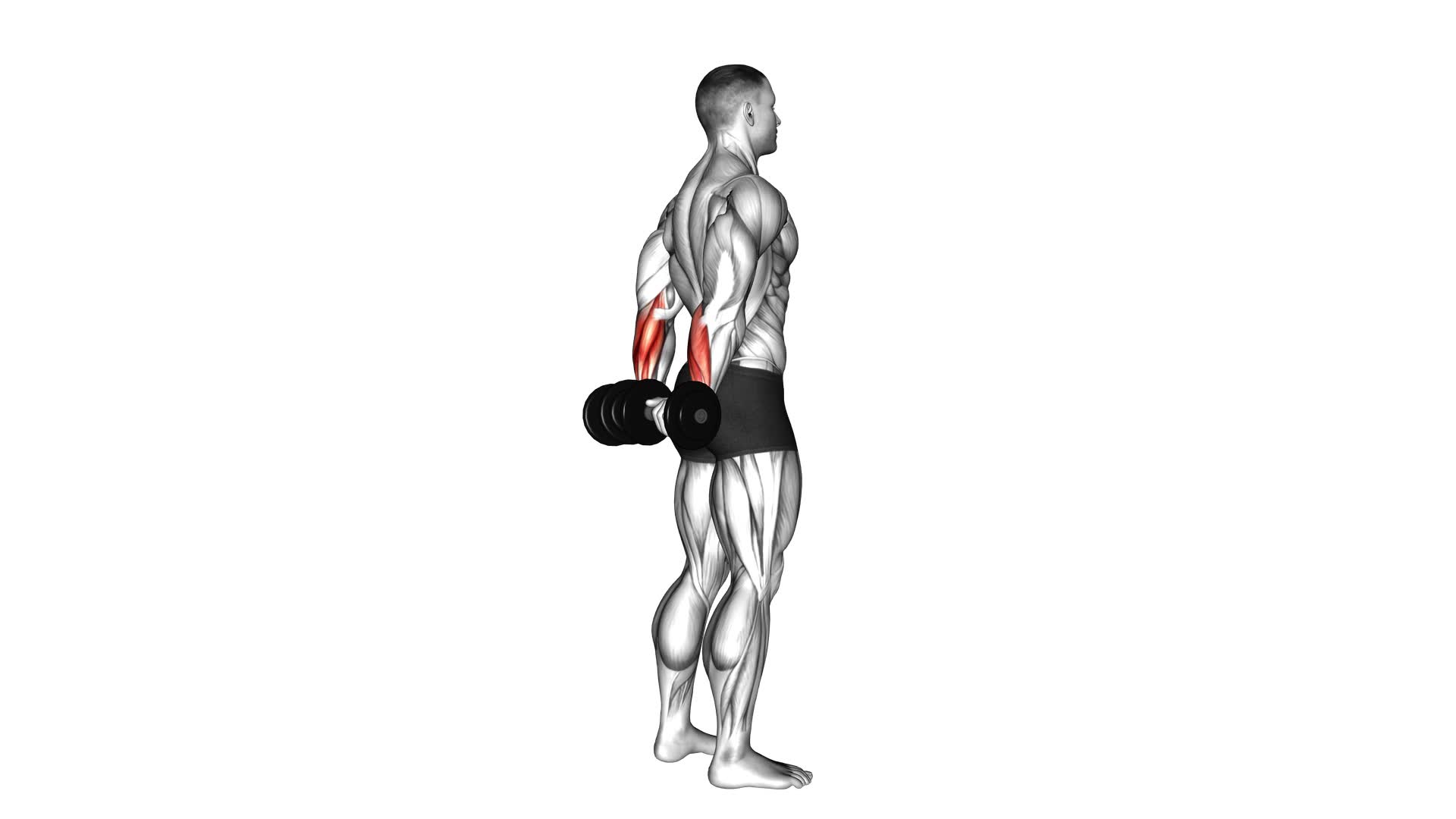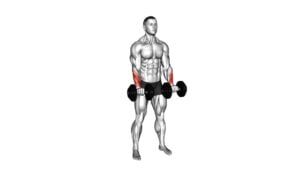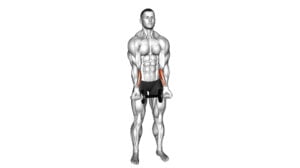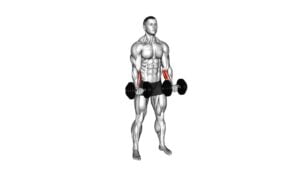Dumbbell Standing Back Wrist Curl – Video Exercise Guide & Tips

Looking to strengthen your wrists and forearms? The Dumbbell Standing Back Wrist Curl is the perfect exercise for you. By using dumbbells, you can target those hard-to-reach muscles effectively.
Watch This Exercise Video
In this video exercise guide, we'll show you the proper form and technique to maximize your results. We'll also provide tips to avoid common mistakes and ways to increase the difficulty as you progress.
Get ready to improve your grip strength with this simple yet effective exercise. Let's get started!
Key Takeaways
- The Dumbbell Standing Back Wrist Curl is beneficial for increasing grip strength and forearm muscle development.
- Proper form and technique include gripping the dumbbell with the palm facing down, keeping the elbow stationary and close to the body, and gradually increasing weight as strength improves.
- Common mistakes to avoid include gripping the dumbbell too tightly, using excessive weight, and rushing through the exercise.
- Tips for increasing difficulty and progression include gradually increasing weight, incorporating resistance bands, trying different grips, and focusing on slow and controlled movement.
Benefits of the Dumbbell Standing Back Wrist Curl
What are the benefits of performing the Dumbbell Standing Back Wrist Curl?
This exercise is highly effective in increasing grip strength and improving forearm muscle development.
By incorporating the Dumbbell Standing Back Wrist Curl into your workout routine, you can target the muscles in your forearms, specifically the wrist extensors, which are responsible for bending your wrists backward.
This exercise involves holding a dumbbell in your hand with your palm facing down and your arm extended in front of you. From this starting position, you slowly lower the dumbbell towards the floor by bending your wrist backward and then return to the starting position by curling your wrist back up.
This repetitive motion engages the muscles in your forearms, helping to strengthen them and promote muscle growth. As a result, you'll experience an increase in grip strength, allowing you to perform better in activities that require a strong grip, such as weightlifting, rock climbing, or playing certain sports like tennis or golf.
Additionally, improved forearm muscle development not only enhances your physical appearance but also boosts your overall upper body strength and stability.
Proper Form and Technique for the Exercise
To perform the Dumbbell Standing Back Wrist Curl exercise with proper form and technique:
- Grip a dumbbell in your hand with your palm facing down and your arm extended in front of you.
- Stand with your feet shoulder-width apart and maintain a neutral spine throughout the exercise.
- Keep your elbow stationary and close to your body as you curl your wrist towards you, using only your forearm muscles.
- Slowly lower the dumbbell back to the starting position, maintaining control and avoiding any jerky movements.
- Perform the exercise for the recommended number of repetitions and sets, gradually increasing the weight as your strength improves.
This exercise is great for improving grip strength, as it targets the muscles in your forearms responsible for wrist flexion. It also helps to enhance wrist flexibility and mobility, which can be beneficial for various activities such as weightlifting, sports, and daily tasks that require strong wrists.
Common Mistakes to Avoid
One common mistake to avoid when performing the Dumbbell Standing Back Wrist Curl exercise is gripping the dumbbell too tightly, which can restrict proper wrist movement and hinder the effectiveness of the exercise. It's important to maintain a firm yet relaxed grip on the dumbbell to allow for smooth and controlled movement of the wrists.
Another common mistake is using excessive weight, which can put strain on the wrists and lead to injury. It's recommended to start with lighter weights and gradually increase the resistance as your wrists become stronger and more accustomed to the exercise.
Additionally, improper positioning of the arms and wrists can also affect the effectiveness of the exercise. Make sure to keep your elbows close to your body and maintain a neutral wrist position throughout the movement.
Lastly, rushing through the exercise or using momentum to lift the weight is another common mistake. It's essential to perform the exercise in a slow and controlled manner, focusing on the contraction of the wrist muscles.
Tips for Increasing Difficulty and Progression
To increase the difficulty and progress in the Dumbbell Standing Back Wrist Curl exercise, you can incorporate heavier weights and gradually increase the resistance as your wrist strength improves. Here are some tips to help you increase difficulty and progression:
- Increase Weight: Start by using dumbbells with a weight that challenges you but still allows you to maintain proper form. As your wrist strength improves, gradually increase the weight to continue challenging yourself and promoting muscle growth.
- Incorporate Resistance Bands: Adding resistance bands to the exercise can provide an extra challenge and increase the difficulty. Attach the resistance bands to a sturdy anchor point and loop them around your wrists. As you perform the wrist curls, the resistance from the bands will further engage your muscles and enhance the workout.
- Try Different Grips: Experiment with different grips to target different muscles and increase the difficulty of the exercise. You can try using an overhand grip, an underhand grip, or a neutral grip to target different areas of the wrists and forearms. Mixing up your grips can help prevent plateaus and keep your progress going.
Safety Precautions and Modifications for Beginners
Safety measures are crucial to prevent injuries and ensure a successful workout. First and foremost, it's important to choose an appropriate weight for your fitness level. Start with a lighter dumbbell and gradually increase the weight as you build strength and confidence. Additionally, maintaining proper form is essential. Keep your back straight, shoulders relaxed, and wrists aligned with your forearms throughout the exercise. Avoid jerking or swinging the weight, as this can strain your wrists and lead to injury.
For beginners who may find the Dumbbell Standing Back Wrist Curl exercise challenging, there are alternative exercises that can be performed. One such exercise is the Seated Wrist Curl. Sit on a bench or chair with your forearm resting on your thigh, palm facing up. Hold a dumbbell in your hand and curl your wrist towards your body, then slowly lower it back down. This exercise targets the same muscles as the Standing Back Wrist Curl but provides more stability and support for beginners.
Frequently Asked Questions
What Is the Recommended Weight for a Beginner to Start With for the Dumbbell Standing Back Wrist Curl?
To find the recommended weight for beginners, start with a weight that challenges you but allows you to maintain proper form.
Gradually increase the weight as you build strength and confidence.
Keep in mind that everyone's starting point may vary, so listen to your body and adjust accordingly.
Can This Exercise Be Done With a Barbell Instead of Dumbbells?
Yes, you can do this exercise with a barbell instead of dumbbells. Using a barbell for the back wrist curl has its benefits. It allows you to lift heavier weights, which can help increase strength and muscle mass in your forearms.
Additionally, using a barbell requires more stability and control, engaging more muscles in your upper body.
However, be sure to start with lighter weights and gradually increase as you get comfortable with the exercise.
How Many Sets and Repetitions Should Be Performed for Optimal Results?
To achieve optimal results with the dumbbell standing back wrist curl, it's crucial to focus on proper form and technique. By performing the exercise with the right technique, you can effectively target your wrist muscles and avoid potential injuries.
Incorporating wrist exercises into your workout routine offers numerous benefits, such as increased wrist strength and stability.
Are There Any Alternative Exercises That Target the Same Muscles as the Dumbbell Standing Back Wrist Curl?
Looking for alternative exercises to target the same muscles as the dumbbell standing back wrist curl? Incorporating wrist exercises into your routine can bring many benefits. By focusing on wrist flexion and extension movements, you can strengthen your forearms, improve grip strength, and enhance overall wrist stability.
Some alternative exercises you can try include:
- Wrist curls with a barbell or cable
- Reverse wrist curls
- Wrist roller exercises
These exercises will help you build strong and functional wrists for a well-rounded upper body workout.
Can This Exercise Be Done Seated Instead of Standing?
Yes, you can definitely do this exercise seated instead of standing. Seated wrist curl variations are a great alternative that target the same muscles.
However, it's important to note that the standing position offers unique benefits such as engaging your core and lower body for added stability and balance.
Conclusion
In conclusion, the dumbbell standing back wrist curl is a beneficial exercise for strengthening the muscles in your wrists and forearms. By following proper form and technique, you can effectively target these muscles and avoid common mistakes.
To challenge yourself and make progress, you can increase the difficulty of the exercise gradually. Remember to prioritize safety and modify the exercise if you're a beginner.
Incorporate this exercise into your routine to improve your wrist strength and overall upper body strength.

Author
Years ago, the spark of my life’s passion ignited in my mind the moment I stepped into the local gym for the first time. The inaugural bead of perspiration, the initial endeavor, the very first surge of endorphins, and a sense of pride that washed over me post-workout marked the beginning of my deep-seated interest in strength sports, fitness, and sports nutrition. This very curiosity blossomed rapidly into a profound fascination, propelling me to earn a Master’s degree in Physical Education from the Academy of Physical Education in Krakow, followed by a Sports Manager diploma from the Jagiellonian University. My journey of growth led me to gain more specialized qualifications, such as being a certified personal trainer with a focus on sports dietetics, a lifeguard, and an instructor for wellness and corrective gymnastics. Theoretical knowledge paired seamlessly with practical experience, reinforcing my belief that the transformation of individuals under my guidance was also a reflection of my personal growth. This belief holds true even today. Each day, I strive to push the boundaries and explore new realms. These realms gently elevate me to greater heights. The unique combination of passion for my field and the continuous quest for growth fuels my drive to break new ground.







